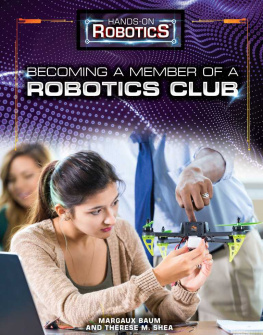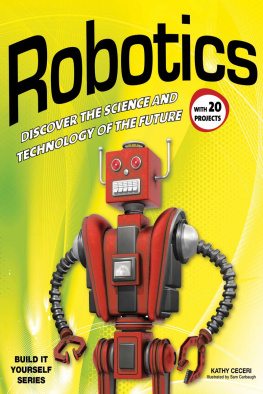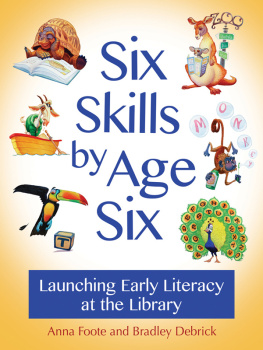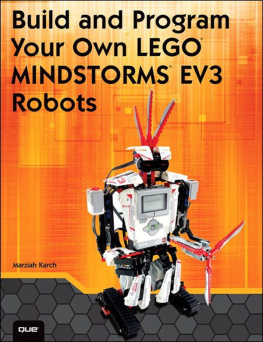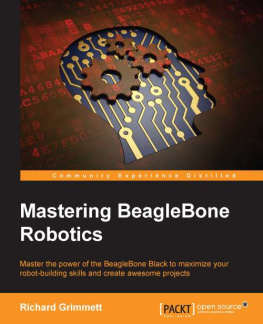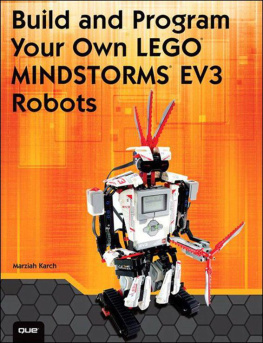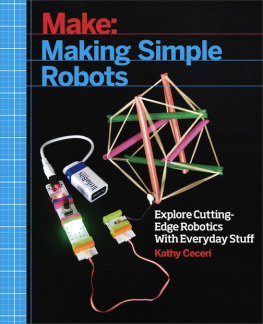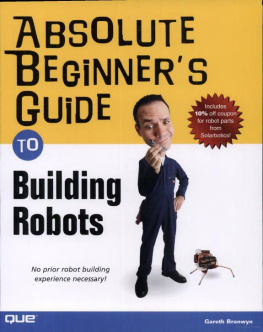About the Author
SARAH KEPPLE founded the Robotix Blox program at Cuyahoga County Public Library where she was Information and Technology Literacy Specialist after over a decade working with youth in school and public libraries. She has presented on participatory technology learning for the Public Library Association, Young Adult Library Services Association, Toy Library Association, and eTech Ohio conference, and has written for YALS and on her blog: www.sarahkepple.com. The founder of Gigalearn, LLC, Kepple holds a BFA from Kent State University, an MLIS from Drexel University, and is a Treu-Mart Youth Development Fellow through Case Western Reserve University.
This work has been greatly inspired by the incredible accomplishments of fellow professionals who have bravely blazed the robotics trail in libraries. Many thanks to the following innovators who shared their stories: Amy Georgopoulos, Beth Barrett, Bob Loftin, Christy Cochran, Kelly Czarnicki, Megan Alabaugh, Michael Cherry, Ryan Paulsen, Tara Radniecki, Tod Colegrove, PhD, and the awesome team of the Robot Test Kitchen: Heather Booth, Kim Calkins, Jacqueline Christen, Sharon Hrycewicz, and Michelle Kilty. Also, even though hes not a librarian, Tad Douce totally rocks too.
Gratitude is also due to LEGO Education for their generous permission to use the screenshots that help illuminate possible solutions. Many thanks in particular to Stephan Turnipseed, Trisha McDonell, and Ivery Toussant, Jr., for their support.
This journey wouldnt have been possible without the five-star team at Cuyahoga County Public Library. Thank you in particular to Sari Feldman, Tracy Strobel, and Wendy Bartlett for your encouragement to write this book, to my friends and colleagues on the Robotix Team, to Julia Boxler and Dave Bullock for helping me storm the castle on more than one occasion, and to Celia Huffman, PhD, my incredible mentor and friend who started and supported me on this path.
Lastly, many thanks are due to all of my friends and family, who have put up with this and all of my other crazy ideas. I would especially like to thank the BDLs, the Club G crew and, most especially, Andrew Harant. You are all rock stars.
Robot Jungle Resources
www.gigalearnit.com/LibraryRobotics/RobotJungle
Follow the White Rabbit Resources
www.gigalearnit.com/LibraryRobotics/WhiteRabbit
Yellow Brick Quest Resources
www.gigalearnit.com/LibraryRobotics/YellowBrick
American Association of School Librarians. Learning Standards & Common Core State Standards Crosswalk. http://www.ala.org/aasl/standards-guidelines/crosswalk.
Connected Learning. Connected Learning Infographic. http://connectedlearning.tv/infographic.
Connected Learning Alliance. http://clalliance.org/.
Flipped Learning Network. http://flippedlearning.org.
Kipling, Rudyard. The Jungle Book. New York: Random House, 2012.
Kipling, Rudyard, Don Daily, and Elizabeth Encarnacion. The Jungle Book. The Classic Edition, first ed. Kennebunkport: Cider Mill Press, 2014.
McGonigal, Jane. Reality Is Broken: Why Games Make Us Better and How They Can Change the World. New York: Penguin Press, 2011.
Partnership for 21st Century Skills. Framework for 21st Century Learning. http://www.p21.org/our-work/p21-framework.
Teaching the Core: A Non-Freaked Out Approach to Literacy, Common Core or Otherwise. The Best of Teaching the Core. http://www.teachingthecore.com/best-of-teaching-the-core/.
In this chapter, well discuss what robots are and how using them as an education tool can increase multiple literacies.
Though generations of humans have pondered mechanical creatures, metal men, and automatons, the word robot first appeared less than a century ago in the 1920 hit play Rossums Universal Robots by Czech playwright Karel Capek (Markel, 2011). Since that time, popular culture has been fascinated with robots both benign and malicious. From the Jetsonss motherly maid Rosie, to human-hunting squidies in The Matrix, to the romantically inclined WALL-E, we just cant get enough.
Although most robots in literature and film are far more sentient and humanoid than the car-building and floor-sweeping robots of reality, they do share a few attributes. Surprisingly, there is no one official definition of what makes a robot a robot, but most tend to have the following in common:
Thinking is what distinguishes a robot from a machine. A machine is a device that performs a task when given power. Robots also use power and mechanical parts to perform tasks, but unlike a machine, robots are programmable and autonomous or semi-autonomous. So, a basic toaster is a machine because its mechanical parts have been constructed to depress and heat the toast when turned on and stop when a timer triggers a release. Whereas, a Roomba floor vacuum is considered a robot because it must take in information about the room and make decisions about which direction to go next. It is programmed with a logical test, and its thinking might go something like this, Is there something in front of me? If so, back up and turn, if not, keep moving forward.
Just as humans and animals use senses such as seeing, hearing, tasting, smelling, and touching to learn about and interact with the world, so robots need sensors to take in information. Robot sensors pick up physical stimuli such as light, heat, sound, pressure, or movement. A perennial favorite program of robotics students is reminiscent of the late 1980s phenomenon The Clapper, a device that uses an electronic sound filter to listen for loud noises and responds by turning an electrical device on or off. In robotics class, we might attach a sound sensor to a robot and program it to start and stop moving when the decibel level of a noise registers above a certain threshold.
So, once our robot has used its sensors to take in data, and that data routes through the brain circuits, we expect something to happen. Whereas humans might have automatic responses to stimuli that are hard-wired into our brains, robots responses must be programmed. Just as we might train a dog to sit every time it hears a command and sees a treat, we would program the robot to respond with a specific action to a certain set of stimuli. Just like the dog, the robot would not only need senses to be able to take in the stimuli and the brain to interpret the stimuli, it would also need the body parts to achieve the brain-triggered response. If a robot is programmed to insert bolts into a car frame every time one comes within a certain distance on the assembly line, it will likely need a rotating mechanical arm of some sort to achieve this response.
Librarians whove experienced Brian Selznicks groundbreaking work The Invention of Hugo Cabret will doubtless remember the pure wonder and joy felt when the automaton produced a drawing seemingly from magic. Perhaps it is this magic, the group animation of individually inanimate parts, that captivates us about robots. No matter their age, those witnessing robots in action, or better yet programming them, invariably find themselves in a bit of awe. But, with everything else libraries must achieve today, with typically very limited funding, being cool may not be enough to warrant the investment required to create and sustain a successful robotics initiative. Robots can, however, be more than just another flashy gizmo or service and can instead be powerful tools to nurture literacy.
Ask any 10 educators to define literacy, and youll get 10 different definitions. Merriam Websters Collegiate Dictionary



